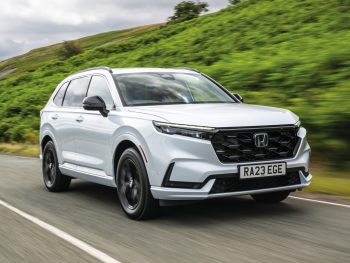First Drive: Honda CR-V
The sixth-generation C-SUV gets plug-in hybrid technology and an upgraded interior. By John Challen.
WHAT IS IT? C-SUV PHEV HOW MUCH? From £53,995 (£45,895 for the e:HEV)
ECONOMY? 353.1mpg EMISSIONS? 18g/km

The new CR-V is the brand’s first PHEV for Europe
The CR-V is a vital model for Honda. Not only because it is the company’s biggest seller, but also because it is battling with some tough competition in the C-segment, such as the Toyota RAV4, Volkswagen’s Tiguan and the Ford Kuga. Beyond that, the Japanese OEM thinks it might have a sniff at tempting drivers out of their BMW X3s and Audi Q5s.
With that in mind, there is quite a lot to digest with the new CR-V. There’s the choice of an all-wheel-drive hybrid (e:HEV) or a plug-in hybrid (e:PHEV) – the brand’s first for Europe. It’s also the first model in the region to feature Sensing 360 – Honda’s all-seeing safety and driver assistance system. More generally, Honda wants the CR-V to combine the best of all worlds, offering ‘the perfect blend of sportiness, practicality and refinement.
A longer length (up 106mm) and wheelbase (up 38mm) mean there’s more useable interior space front and back – putting the CR-V on a par with some D-segment contenders. In the rear, there’s more legroom, while the seats recline an extra 10.5° over the outgoing model, with eight different reclinable options.
Up front, drivers have the dual setup of a 9.0-inch centrally mounted infotainment screen, alongside a 10.2-inch set of digital dials behind the steering wheel. Head-up display is available on all but the base spec model, while a re-designed central armrest is now semi-automated, opening to 60 degrees automatically and a further 30 degrees manually. Drivers have a better view of the road thanks to more space between the rear-view mirrors and A-pillars, which have been optimised for improved aerodynamics.
The powertrain in both the e:HEV and e:PHEV features a 146hp, 2.0-litre DI Atkinson-cycle petrol engine, as seen in the Civic Hybrid, but revised for the SUV. This engine works in the PHEV CR-V with an updated dual electric motor automatic transmission, alongside a 17.7kWh battery (cleverly packaged under the floor to enable a boot capacity of 586 litres) and on-board charger. These improvements mean engine speeds are kept lower, helping both fuel efficiency and interior noise levels.
With a fully charged battery, the e:PHEV will offer a pure electric range of up to 50 miles and WLTP CO2 and consumption figures of 18g/km and 353.1mpg respectively. Improvements to the powertrain mean torque has increased by 6.5% to 335Nm with a total output of 181hp. Performance-wise, the CR-V reaches 0-62mph in 9.4 seconds and a top speed of 116mph.
The e:HEV is available in Elegance and Advance trims, while the Advance Tech is reserved for the plug-in CR-V. All models feature the Sensing 360 technology, leather heated seats, rear-view camera, wireless charging and keyless entry and start. Step from Elegance to Advance and drivers get a multi-view camera, upgraded audio system, head-up display and upgraded front lights. The range-topping Advance Tech adds parking pilot, towing capability, powered tailgate and much more.
IN BRIEF
Key fleet model: e:PHEV
Pros: Interior space, driving experience
Cons: Cost, quality of some interior materials
7-word summary: More premium feel, but premium price too
Also consider: Ford Kuga / Toyota RAV4 / Volkswagen Tiguan












